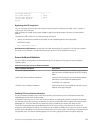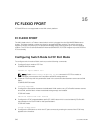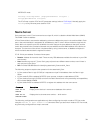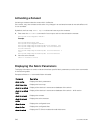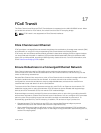
FCoE Maps
To identify the SAN fabric to which FCoE storage traffic is sent, use an FCoE map.
Using an FCoE map, an NPG operates as an FCoE-FC bridge between an FC SAN and FCoE network by
providing FCoE-enabled servers and switches with the necessary parameters to log in to a SAN fabric.
An FCoE map applies the following parameters on server-facing Ethernet and fabric-facing FC ports:
• The dedicated FCoE VLAN used to transport FCoE storage traffic.
• The FC-MAP value used to generate a fabric-provided MAC address.
• The association between the FCoE VLAN ID and FC fabric ID where the desired storage arrays are
installed. Each Fibre Channel fabric serves as an isolated SAN topology within the same physical
network.
• A server uses the priority to select an upstream FCoE forwarder (FCF priority).
• FIP keepalive (FKA) advertisement timeout.
NOTE: In each FCoE map, the fabric ID, FC-MAP value, and FCoE VLAN must be unique. To access
one SAN fabric, use one FCoE map.
When you configure an MXL as an NPG, FCoE transit with FIP snooping is automatically enabled and
configured using the parameters in the FCoE map applied to server-facing Ethernet and fabric-facing FC
interfaces.
After you apply an FCoE map on an FC port, when you enable the port (using the no shutdown
command), the NPG starts sending FIP multicast advertisements on behalf of the FC port to downstream
servers to advertise the availability of a new FCF port on the FCoE VLAN. The FIP advertisement also
contains a keepalive message to maintain connectivity between a SAN fabric and downstream servers.
NOTE: After removing and reapplying the fabric map or after modifying the FCoE map, the Fiber
Channel (FC) devices do not re-login. To mitigate this issue, you must first run the shut command
and then the no shutdown command on each member interface after you alter the FCOE map.
Creating an FCoE Map
An FCoE map consists of the following elements.
• An association between the dedicated VLAN used to carry FCoE traffic and SAN fabric where the
storage arrays are installed. Use a separate FCoE VLAN for each fabric to which FCoE traffic is
forwarded. Any non-FCoE traffic sent on a dedicated FCoE VLAN is dropped.
• The FC-MAP value used to generate the fabric-provided MAC address (FPMA). The server uses the
FPMA to transmit FCoE traffic to the fabric. You can associate an FC-MAP with only one FCoE VLAN
and vice versa.
• FCF priority: a CNA server uses the priority to select an upstream FCoE forwarder (FCF).
• FIP keepalive (FKA) advertisement timeout.
342
FC FLEXIO FPORT




